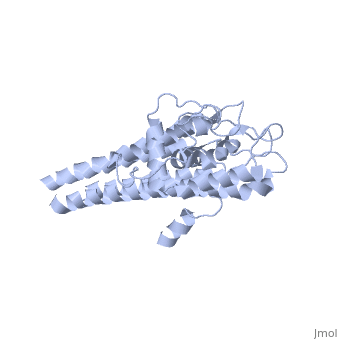User:Mumal Usman/Sandbox 1
From Proteopedia
| Line 4: | Line 4: | ||
<Structure load='1l8w' size='300' frame='true' align='right' caption='VlsE Surface Protein' /> | <Structure load='1l8w' size='300' frame='true' align='right' caption='VlsE Surface Protein' /> | ||
The successful infection of Lyme disease can be attributed to its many membrane proteins. The surface lipoprotein, | The successful infection of Lyme disease can be attributed to its many membrane proteins. The surface lipoprotein, | ||
| - | <scene name='1l8w'>VlsE</scene> | + | <scene name='1l8w'>VlsE</scene>, is responsible for the infectious properties of the Lyme disease spirochete, Borrelia burgdorferi[1]. VlsE uses several immune evasive strategies, giving the disease its characteristically infectious behavior. Specifically, antigenic variation and suppression of innate and acquired immune response aid the disease in remaining in the host[2]. Antigenic variation is the most efficient strategy in order to protect the infectious properties of the spirochete[3]. Expressed antigenic variation is produced by segmental gene conversation through variable regions of the lipoprotein[4,5]. |
== Structure == | == Structure == | ||
| + | Approximately 75% of the VlsE protein primary structure is invariable and highly conserved[3]. There are N and C terminal regions of invariability, or direct repeats, which flank the cassette region where the invariable regions of the cassette resideiii, . Within the cassette region exists silent cassettes that are unexpressed. Assuring the survival of the invariable regions is of utmost importance for proper structure and physiological function of the protein. By encasing the invariable regions within the distal core of the protein, the variable regions protect the invariable regions from the host immune system. | ||
| + | The protein is made up of eleven alpha(α) helices, seven of which (α4-α10) reside in the core region of the distal portion of the protein[3]. These α-helices make up the cassette region of the protein, within which there are six variable regions (VR) and six invariable regions (IR)[1,3] . The six variable regions provide the variation necessary to evade the host immune systemi. Variability is produced via amino acid substitutions concentrated to a small portion of the variable region, which likely produces a conformational change of the epitope allowing it to elude the host immune system[3]. | ||
| + | |||
| + | |||
| + | Although the exact function of the VlsE surface lipoprotein is unknown, three invariable regions are of particular interest, | ||
| + | <scene name='User:Mumal_Usman/Sandbox_1/246_surface_exposure/3'>IR2, IR4, and IR6 '''(INCORRECT IMAGE IS LINKED)'''</scene> [1,3]. IR6 forms alpha helix 10, which is almost entirely buried within the center of the membrane distal regions encased by the variable regions, it has only 13.7% surface exposure[3] (GREEN LINK). IR2 and IR4 were also found to have significant antigenicity, however only in mice and at much lower rates when compared to IR6[1]. By encasing these invariable regions within the distal core of the protein, the variable regions provide protection for the invariable regions from the host immune system. | ||
<scene name='User:Mumal_Usman/Sandbox_1/Testing/3'>Info about IR Regions</scene> | <scene name='User:Mumal_Usman/Sandbox_1/Testing/3'>Info about IR Regions</scene> | ||
Revision as of 06:27, 30 April 2012
Introduction
|
The successful infection of Lyme disease can be attributed to its many membrane proteins. The surface lipoprotein, , is responsible for the infectious properties of the Lyme disease spirochete, Borrelia burgdorferi[1]. VlsE uses several immune evasive strategies, giving the disease its characteristically infectious behavior. Specifically, antigenic variation and suppression of innate and acquired immune response aid the disease in remaining in the host[2]. Antigenic variation is the most efficient strategy in order to protect the infectious properties of the spirochete[3]. Expressed antigenic variation is produced by segmental gene conversation through variable regions of the lipoprotein[4,5].
Structure
Approximately 75% of the VlsE protein primary structure is invariable and highly conserved[3]. There are N and C terminal regions of invariability, or direct repeats, which flank the cassette region where the invariable regions of the cassette resideiii, . Within the cassette region exists silent cassettes that are unexpressed. Assuring the survival of the invariable regions is of utmost importance for proper structure and physiological function of the protein. By encasing the invariable regions within the distal core of the protein, the variable regions protect the invariable regions from the host immune system.
The protein is made up of eleven alpha(α) helices, seven of which (α4-α10) reside in the core region of the distal portion of the protein[3]. These α-helices make up the cassette region of the protein, within which there are six variable regions (VR) and six invariable regions (IR)[1,3] . The six variable regions provide the variation necessary to evade the host immune systemi. Variability is produced via amino acid substitutions concentrated to a small portion of the variable region, which likely produces a conformational change of the epitope allowing it to elude the host immune system[3].
Although the exact function of the VlsE surface lipoprotein is unknown, three invariable regions are of particular interest,
[1,3]. IR6 forms alpha helix 10, which is almost entirely buried within the center of the membrane distal regions encased by the variable regions, it has only 13.7% surface exposure[3] (GREEN LINK). IR2 and IR4 were also found to have significant antigenicity, however only in mice and at much lower rates when compared to IR6[1]. By encasing these invariable regions within the distal core of the protein, the variable regions provide protection for the invariable regions from the host immune system.
| |||||||||||

